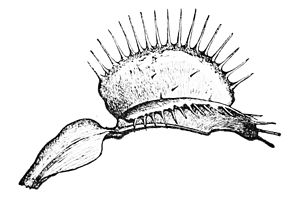figurement of a brain, and we can almost fancy that we detect a trace of disappointment or regret in this admission.
A wide range of experiment shows that probably all the species of Drosera are adapted for catching and digesting insects by nearly the same means, though not with equal development or completeness.
Dionæa muscipula.—The form of the bilobed leaf which is the most wonderful feature of this wonderful plant, already described, may be seen from the accompanying sketch.

Fig. 6.—Dionæa muscipula.—Leaf viewed laterally in its expanded state.
In the Dionæa the locality of sensitiveness is the three filaments which appear on each half of the upper surface of the leaf. It is un-like Drosera in that the filaments are sensitive to sudden impact, the transmission of the impulse is more rapid and the consequent movement instantaneous. Another point of unlikeness consists in the power of secretion of the glands, those of Dionæa being only excited by the absorption of nitrogenous matter. When any substance comes in contact with the filaments, the lobes of the disk close instantly upon it, confining it in a concave chamber; if the imprisoned matter be nitrogenous the lobes are gradually pressed closer together, the glands secrete freely and reëxpansion takes place only after from nine to twenty-four days, when nearly all trace of the substance will have disappeared, and sensitiveness is lost, only to reappear after some time has elapsed, if at all. If, however, the closing is the result of sudden impact or of the contact of a non-nitrogenous substance, the leaf shortly opens again and is at once sensitive, the glands showing no signs of secretion. The constitution and action of the secretion are identical with those of Drosera, as is probably the manner of transmission of the motor impulse. But want of space again excludes many interesting details.
Aldrovanda, Drosophyllum, Roridula, and Byblis, four other genera of the same order, all are provided with secreting glands and seem to have similar powers, though in a lesser degree.
Mr. Darwin was also led to investigate the habits of Pinguicula
